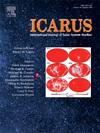Dynamical origin of Theia, the last giant impactor on Earth
IF 3
2区 物理与天体物理
Q2 ASTRONOMY & ASTROPHYSICS
引用次数: 0
Abstract
Cosmochemical studies have proposed that Earth accreted roughly 5%–10% of its mass from carbonaceous (CC) material, with a large fraction delivered late via its final impactor, Theia (the Moon-forming impactor). Here, we evaluate this idea using dynamical simulations of terrestrial planet formation, starting from a standard setup with a population of planetary embryos and planetesimals laid out in a ring centered between Venus and Earth’s orbits, and also including a population of CC planetesimals and planetary embryos scattered inward by Jupiter. We find that this scenario can match a large number of constraints, including (i) the terrestrial planets’ masses and orbits; (ii) the CC mass fraction of Earth; (iii) the much lower CC mass fraction of Mars, as long as Mars only accreted CC planetesimals (but no CC embryos); (iv) the timing of the last giant (Moon-forming) impact; and (v) a late accretion phase dominated by non-carbonaceous (NC) bodies. For this scenario to work, the total mass in scattered CC objects must have been , with an embryo-to-planetesimal mass ratio of at least 8, and CC embryos in the mass range. In that case, our simulations show there are roughly 50-50 odds of Earth’s last giant impactor (Theia) having been a carbonaceous object — either a pure CC embryo or an NC embryo that previously accreted a CC embryo. Our simulations thus provide dynamical validation of cosmochemical studies.
忒伊亚的动力起源,地球上最后一个巨大的撞击物
宇宙化学研究提出,地球大约5%-10%的质量来自碳质(CC)物质,其中很大一部分是通过最后的撞击器忒伊亚(月球形成撞击器)产生的。在这里,我们使用类地行星形成的动态模拟来评估这个想法,从一个标准的设置开始,在金星和地球轨道之间的一个环中放置了一群行星胚胎和星子,还包括一群CC星子和由木星向内分散的行星胚胎。我们发现这种情况可以匹配大量的约束条件,包括(i)类地行星的质量和轨道;(ii)地球CC质量分数;(iii)火星的CC质量分数要低得多,只要火星只吸积CC星子(但没有CC胚);(iv)最后一次巨大(月球形成)撞击的时间;(v)以非碳质(NC)体为主的晚期吸积阶段。要使这一假设成立,分散的CC天体的总质量必须为~ 0.2 ~ 0.3M⊕,胚胎与星子的质量比至少为8,而CC胚胎的质量范围必须在~ 0.01 ~ 0.05M⊕。在这种情况下,我们的模拟显示,地球上最后一个巨大的撞击物(忒伊亚)大约有50%的几率是一个碳质物体——要么是一个纯粹的CC胚胎,要么是一个之前吸积了一个CC胚胎的NC胚胎。因此,我们的模拟为宇宙化学研究提供了动态验证。
本文章由计算机程序翻译,如有差异,请以英文原文为准。
求助全文
约1分钟内获得全文
求助全文
来源期刊

Icarus
地学天文-天文与天体物理
CiteScore
6.30
自引率
18.80%
发文量
356
审稿时长
2-4 weeks
期刊介绍:
Icarus is devoted to the publication of original contributions in the field of Solar System studies. Manuscripts reporting the results of new research - observational, experimental, or theoretical - concerning the astronomy, geology, meteorology, physics, chemistry, biology, and other scientific aspects of our Solar System or extrasolar systems are welcome. The journal generally does not publish papers devoted exclusively to the Sun, the Earth, celestial mechanics, meteoritics, or astrophysics. Icarus does not publish papers that provide "improved" versions of Bode''s law, or other numerical relations, without a sound physical basis. Icarus does not publish meeting announcements or general notices. Reviews, historical papers, and manuscripts describing spacecraft instrumentation may be considered, but only with prior approval of the editor. An entire issue of the journal is occasionally devoted to a single subject, usually arising from a conference on the same topic. The language of publication is English. American or British usage is accepted, but not a mixture of these.
 求助内容:
求助内容: 应助结果提醒方式:
应助结果提醒方式:


